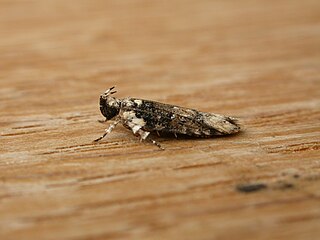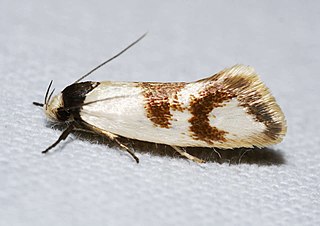
Trachypepla semilauta is a moth of the family Oecophoridae and was first described by Alfred Philpott in 1918. It is endemic to New Zealand and has been collected in Southland. This species inhabits southern beech forest on the side of mountains. Adults are on the wing in January.
Eurhythma argyphea is a moth in the family Crambidae. It was described by Turner in 1913. It is found in Australia, in the Northern Territory.
Prionapteryx hedyscopa is a moth in the family Crambidae. It was described by Oswald Bertram Lower in 1905. It is found in Australia, where it has been recorded from New South Wales.
Ptychopseustis eutacta is a moth in the family Crambidae. It is found in Australia, where it has been recorded from Queensland.

Pyrausta comastis is a moth in the family Crambidae. This species is endemic to New Zealand. It has been classified as "nationally vulnerable" by the Department of Conservation.
Trigonoorda rhodopa is a moth in the family Crambidae. It was described by Alfred Jefferis Turner in 1908. It is found in Australia, where it has been recorded from Queensland and the Northern Territory.
Archernis argocephala is a moth in the family Crambidae. It was described by Oswald Bertram Lower in 1903. It is found in Australia, where it has been recorded Queensland.
Criophthona trileuca is a moth in the family Crambidae. It is found in Australia, where it has been recorded from Western Australia.
Metasia phragmatias is a moth in the family Crambidae. It was described by Oswald Bertram Lower in 1903. It is found in Australia, where it has been recorded from Queensland.
Nacoleia megaspilalis is a moth in the family Crambidae. It was described by George Hampson in 1912. It is found in Andhra Pradesh in India and Queensland in Australia.
Ardozyga acroleuca is a species of moth in the family Gelechiidae. It was described by Edward Meyrick in 1904. It is found in Australia, where it has been recorded from New South Wales and Victoria.
Ardozyga tetraploa is a species of moth in the family Gelechiidae. It was described by Edward Meyrick in 1904. It is found in Australia, where it has been recorded from Victoria.

Ardozyga sodalisella is a species of moth in the family Gelechiidae. It was described by Francis Walker in 1864. It is found in Australia, where it has been recorded from Queensland and New South Wales.
Aristotelia hemisarca is a moth of the family Gelechiidae. It was described by Oswald Bertram Lower in 1916. It is found in Australia, where it has been recorded from New South Wales.
Dorycnopa triphera is a moth of the family Gelechiidae. It was described by Oswald Bertram Lower in 1920. It is found in Australia, where it has been recorded from South Australia.
Eutorna intonsa is a moth in the family Depressariidae. It was described by Edward Meyrick in 1906. It is found in Australia, where it has been recorded from Victoria, New South Wales and Tasmania.
Eupselia hypsichora is a moth in the family Depressariidae. It was described by Edward Meyrick in 1906. It is found in Australia, where it has been recorded from Western Australia.
Eupselia leucaspis is a moth in the family Depressariidae. It was described by Edward Meyrick in 1906. It is found in Australia, where it has been recorded from South Australia and Western Australia.

Antipterna trilicella is a species of moth in the family Oecophoridae, first described by Edward Meyrick in 1885 as Ocystola trilicella. It appears to be a moth endemic to Australia and confined to the east coast, occurring in Victoria, New South Wales and Queensland.

Chrysorthenches porphyritis is a species of moth of the family Plutellidae. It was first described by Edward Meyrick in 1885 and is endemic to New Zealand. This species can be found on both the North and South Islands in open native forest and scrub at altitudes from sea level up to 1370 m. The larvae feed on Podocarpus laetus, P. totara, P. nivalis, and Phyllocladus alpinus. The larvae create a shelter by loosely spinning together the leaves of its host plant and can be found feeding in groups. The pupa is formed inside a thin cocoon. Hudson was of the opinion that this species had two broods a year. Adult moths are on the wing all year round. The adults of this species, particularly the female, are variable in colouration and in forewing pattern.




